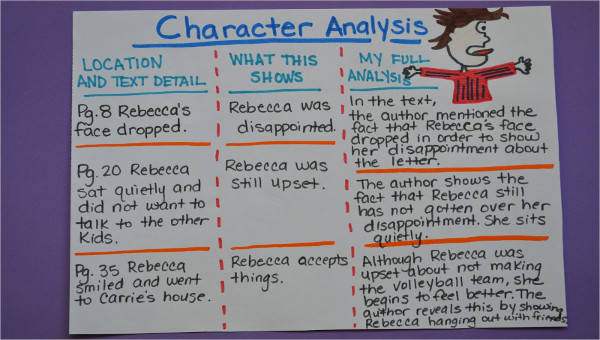Ace that Character Analysis Essay!
Published 11-06-2023
23167

Ace that Character Analysis Essay!
A relatable definition of a character analysis essay is a paper written by students in English or Literature courses and basically involves describing a character or characters in the context of a story. Normally, this is achieved by exploring the link between the said character in question and other characters. Presentation of personal views and analysis of a given character is, sometimes, allowed. Other than defining what a character analysis paper is, this article not only explains how to approach it but also touches on how to evaluate will also touch on analyzing characters as well as how to perform a character summary and writing a good character analysis paper in general in order to ace that character analysis essay.
The parts that follow highlights the nitty gritty on how to perform a character analysis by further describing a character analysis paper and how our able character analysis essay writers, whom we fondly refer to as night owls, can help you in writing a good character analysis paper or give you a comprehensive guide on how to analyze characters to enable you ace that character analysis essay.
Character Analysis Essay: What is it?
What is a character analysis? How to write a character analysis? These are some of the questions people often ask. A broad defection of a character analysis essay is an essay which describes and evaluates the personality characteristics and traits of certain persona or character in a given piece of literary work. While the characters are mostly from literature, they are at times derived from other forms of art like cinematography.
Typically, analysis of characters informs the audience of a certain character in terms of who they are as well as the role they place in a certain piece of work, say a story. As such, writing a good character analysis paper requires one to be objective and to employ their critical thinking skills in analyzing the chosen character, and highlighting their personal preferences and opinions only. This is because analyzing a character requires one to look at their character from the lens of many characteristics, among them their behavior, relationship with others, how they look and manner of speaking.
Character analysis cannot be limited to being part of or section of English or Literature courses but, it is a life skill that one needs to have since a personal opinion and analysis of a given character in real life is appropriate sometimes.
Purpose of writing a character analysis essay
Other than being part of fulfilling the English or Literature course or unit requirement, character analysis essays assist readers in understanding characters as well as their worlds. One important purpose of writing a character analysis paper is to explore characters’ anatomy in the story and evaluate who they really are in a bid to know the characters were built and gain valuable insights from their lives.
Sparknotes provides a an excellent analysis of a character from “The Great Gatsby,” Daisy Buchanan, by first explaining who she was, where she was from and the relationship she has with Jay Gatsby. Sparknotes provides an overview of the plot, hence suggesting the need to include the plot as you plan to write a character analysis paper. Sparknotes does not assume that everybody has read the book, and so shouldn’t you! However, in cases where one is certain that the reader has no or little knowledge about the character, it is important to include robust information to familiarize them with the character being analyzed.
Sparknotes does this perfectly well and goes on to highlight the character of Daisy Buchanan via certain situations that involve her as well as what she did or said. The essay by Sparknotes explains to the audience why certain scenes are included and how they depict the character of Daisy Buchanan. Lastly, the essay concludes by providing a summary of all the main points and clearly states the role and purpose of the character of Daisy Buchanan in the story.
Stuck on how to write a great conclusion? We recommend reading writing impressive conclusions.
Different Types of Characters
It should be noted that various characters are anchored on their traits, behaviors and roles within a given story. Knowing this is fundamental in that it makes it clear how readers can know more about any given persona in a piece of work, be it an art or literature.
It is for this particular reason that Literary Owls has collected some of the renowned works and used them to highlight the differences in how characters are depicted.
Types of Characters
Major characters
Major characters are the main ones and the story is mostly about, or revolves around, them. The main characters are often one or two, and can either be the protagonist (denoting the hero in a story) or the antagonist (the villain or the bad guy).
Protagonist(s) (the good guy):
This is the main character on which the story is based and, every story must have a main protagonist. The absence of a protagonist renders the entire plot baseless. Some of the renowned protagonists are listed below;
- Epics - Helen of Troy, Oedipus, Lord Krishna,
- British Literature - Romeo and Juliet, Mr. Darcy & Elizabeth Bennet, Sherlock Holmes, James Bond, Oliver Twist, Robin Hood, Lancelot, Emma, Othello, Harry Potter, Butler Jeeves, Count Dracula, Matilda
- American Literature - Atticus Finch, Scarlett O’Hara & Rhett Butler, Tom Sawyer & Huckleberry Finn
More often than not, protagonists are the good guys or heroes in literary works and they are mostly depicted as having gone through a journey of transformation and/or having learnt an important lesson. Nonetheless, there are cases of protagonists that are villains or anti-heroes. In this case, they are the main characters that do not always do the right thing, are morally ambivalent or do right for wrong reasons.
Anti-hero protagonists often do bad things yet the readers/viewers root for them. Examples include Dexter in Dexter, Tyrion Lannister from Game of Thrones, Captain Jack Sparrow from the Pirates of the Caribbean, and Walter White from Breaking Bad. It should be noted that in as much as the story is often told by the protagonist from their first-person perspective, the protagonist is not always the narrator. As such, it is not uncommon to find a minor or major character being the narrator and telling the story. Such is the case in “The Great Gatsby” where Nick is looking in and telling the story.
Antagonist(s):
This is normally the “enemy” or the villain, or simply the character whose conduct opposes everything that the protagonist stands for. Whereas this is often the case, it isn’t always the case that the antagonist is the enemy or villain. The antagonist, in some cases, is simply a person or character that impedes the protagonist’s way or create a stumbling block, even if it is in good faith.
- Our night owls have compiled a list of renowned antagonists;
- Voldemort in Harry Potter
- Saruman in The Lord of the Rings
- Darth Vader in The Empire Strikes Back
- The Joker in The Dark Knight
- Captain Hook in Peter Pan
Read more here: Antagonist examples in film
Minor characters
These are the side characters that contribute less while adding a lot to the story’s plot and context. Also known as supporting characters, minor characters can be individuals that are mentioned one in a while or those that have to be mentioned or included in order for the plot to flow. An excellent example of minor character is a family member or a courier that has to deliver the letters of the main character. Take for instance the Lando Calrissian, Jabba the Hutt, Obi-Wan Kenobi and Yoda in the Star Wars universe. These characters constantly support the protagonist Luke Skywalkert and other main characters such as Darth Vader, Han Solo and Leia in their character development and adventures and they would not have succeeded in their absence.
Some of the commonly known minor character examples include;
- Samwise Gamgee – The Lord Of The Rings by J. R. R. Tolkien
- Bones – Halfway To The Grave by Jeaniene Frost
- Cinna – The Hunger Games by Suzanne Collins
- Radar – Paper Towns by John Green
- Ron – Harry Potter And The Sorcerer’s Stone by J. K. Rowling
Read more: 5 Minor Character Examples
Other than being considered a major, minor, protagonist or antagonist, character can by static, dynamic or foil.
Static characters
These characters are unchanging and basically in every part of the story and never grow or change much. Generally, the audience do not learn much (such as history or background) about these characters but, they play important roles in the story nonetheless. Minor characters are often static.
Dynamic characters
These characters experience significant changes in terms of growth throughout the entire story. The protagonists are excellent examples of a dynamic characters since they gain new life lessons to become better people. Nonetheless, they transformations are not always positive as is the case in the Star Wars where Anakin Skywalker starts out as a heroic Jedi and eventually becomes the Dark Lord of the Sith Darth Vader.
Foil characters
Literary foils are characters that exist to develop contrasts against the protagonist and often placed to depict some features of the qualities and personality traits, among others, of the protagonists. Foils are not necessarily antagonists or villains but characters whose set of values differ from the protagonists’. Foils can be protagonists friends to which they are meant to draw attention. An excellent example of a foil is Dr. John Watson in Sherlock Holmes by Arthur Conan Doyle. Watson’s relative obtuseness highlights the brilliance of Holmes's deductions, hence is a perfect foil for Holmes.
How to write a character analysis
You may be concerned about how to write a character analysis essay and preparing to analyze a certain character in a story. The first step is reading the story carefully, with specific emphasis to the following;
- Give close though to circumstances involving the character as well as their interactions, conversations and roles in the context or plot.
- Ensure to incorporate information on the character’s substantial achievements and the influence that the achievements have on other characters.
- Do not limit your thoughts to the categorization above. Instead, one should think outside the box and evaluate the character from a holistic perspective.
- General statements ought to be avoided, and place emphasis on exploring details and complexities of the character instead.
Ace that character analysis essay: How to character analysis!
One ought to immerse themselves fully into the plot of the story, film or any other literary work in order to profoundly understand a characters and thus write an A+ character analysis essay or paper.
So, how do you go about writing a good character analysis paper?
- Pay attention to the story’s setting, context, climax as well as other notable academic apects.
- Ensure to see through the characters and observe how the characters are brought to life by the writer.
- Note how vast or little the identities of character are described.
- Observe the behaviors and morals of the characters as well as how they influence other characters and situations in the plot/story.
- Lastly, take note of the interesting characters.
In the meantime, you can avail Literary Owls’ assignment writing advisory services or make use of our editing and proofreading services if you need assistance writing a paper or essay.
How Do You Start writing a good character analysis paper?
When looking to write a character analysis to ace that character analysis essay, the first step is selecting a character on which you would like to write. While the character may be assigned to you in class, consider dynamic characters when at liberty to choose as this will not only interest the audience by also ease your character analysis essay writing since a lot of information about the character will be available.
Reading the book or watching the film is perhaps the very first step in performing a character analysis. This is despite having selected the character or knowing more about them since re-reading or re-watching has plenty of benefits such as being more precise while watching/reading scenes directly relating to the character and critical to their analysis.
Attention to the tiniest details is key to grasping the character's traits while reading/watching. It is important to consider the following;
The descriptions given to the character
In the case of J.K. Rowling’s Harry Potter, the main character is depicted as having oversized and old clothes, wearing broken glasses, and having untidy hair in the first instance. Whereas one may understand this as a simplistic depiction, J.K. Rowling highlights the predicaments of Harry Potter in such a way that elicits pity and compassion for an orphan whose relatives have failed to provide for.
The types of relationships that the character has with others
Still on J.K. Rowling’s Harry Potter, consider how Harry establishes relationships with peers. Initially, Harry together with his friend Ron dislike Hermione as she is thinks she is a smarty-pants but save her nonetheless when she is stuck with a horrendous troll in the dungeons.
How the character’s actions influence the plot
Harry Potter and the Philosopher's Stone is perhaps the most relatable example to use to highlight this aspect. Consider when Harry Potter observes the events that occur at his school and how he evaluates what people do, thus developing the plot based on the stone as well as its significance in the magical world.
Literary Owls’ night owls also provide Assignment advisory services, Essay writing, proofreading and editing, Nursing case study advisory service, and Nursing essay advisory service, among other custom writing services!
Always select a Dynamic Character for your character analysis paper!
Selecting a dynamic character for your character analysis essay is a wise decision. As stated earlier, a dynamic character is not necessarily the protagonist. Just choose a character that experiences significant changes as the story progresses as opposed to static or boring ones.
In selecting a dynamic character, you will be better positioned to describe the character better while being charming in your paper, hence engaging the audience better. Choosing a static character means that you are more likely to do less and thus be less engaging to the reader.
Writing a good character analysis paper requires you to take notes
Read the story while taking notes as this ensures that you give attention to the important elements of the story. Highlighting important aspects of the story through note-taking helps you in adding the depth to how you describe your character(s). This also enables you to provide relatable and clear examples in the story, thereby connecting the audience to the character.
Keep your character in mind while reading the story and making your notes then review them upon completion. This is followed by formulation of the main idea about the character being analyzed and the development of the first draft that takes into account the professor-provided outline of the character analysis essay. In case your professor has not provided a specific outline, please follow the standard character analysis essay outline and/or format.
Read more on how to select the main idea, writing a character analysis thesis statement, character analysis questions, character analysis paper outline and conclusion in our NEXT BLOG POST.
Ace that character analysis essay with Literary Owls' Character Analysis Essays Writing Service!
Hacking a character analysis essay can be difficult and complicated, as if walking in a dense forest without a compass. Literary Owls has a team of seasoned literary experts and night owls ready to guide you through the wilderness of literary character analysis. We have got your back every step of the way, from brainstorming ideas to polishing your final draft.
You might be wondering, "How does essay help service work?" Well, it is simple! Just reach out to us with your assignment details via either Live Chat (bottom-right), email ([email protected]) or Text/WhatsApp/Telegram (+1 (628) 201 7932). Our night owls will swoop in to provide personalized assistance tailored to your specific needs. Our night owls are here to lend a helping wing, irrespective of whether you are grappling with character development, thematic exploration, or creating a compelling thesis statement.
Character analysis essays serve as a gateway into the literary world, offering readers a deeper understanding of their favorite protagonists and antagonists alike. But, where do you begin? Worry less, because Literary Owls is here to help you with all your character analysis essay needs!
Our Night Owls also provide scholarly writing advisory services such as counsel in dissertation, thesis, lab report and research paper writing, among others, in various disciplines.
Do not wait for the deadline, click and order now and trust us to do the rest for you.
Ace your papers with Literary Owls’ custom writing advisory services!




